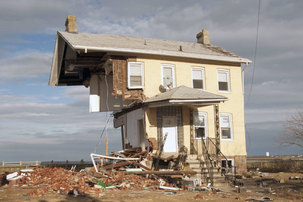
Gov. Phil Murphy traveled to Union Beach, one of the Shore communities hardest hit by the massive storm, to announce the state plans to redirect $50 million in unspent funds to a program that would provide no-interest loans to homeowners. Those loans could be forgiven eventually, if residents have already received a $150,000 grant from a major homeowner-relief program but still could not pay all the costs of rebuilding.
“We could congratulate ourselves all we want on the rebuilding … however, we cannot stop until every family in every Sandy-impacted community is once again able to walk back to the doors of their homes,” said Murphy, after noting that most of the state’s residents, businesses, and boardwalks have returned to normal. But while 330 homeowners in Union Beach have been able to rebuild, 56 have not. Statewide, the number is “1,200 families six years later. We must get them back into their homes.”
Help for the hardest hit
Murphy also announced an official moratorium on the state’s seeking repayment from owners who have been unable to prove they spent all aid appropriately, along with an “extreme financial hardship allowance” that could lead to the state forgiving so-called clawbacks, which seek to recover money already disbursed. Owners will apply for an allowance to the state Department of Community Affairs, which will evaluate each individual’s ability to recoup aid. Proven cases of extreme hardship — including those who lost a home to foreclosure or who declared bankruptcy — would have their debt reduced or eliminated.
This “new approach … will no longer employ collection agency tactics,” Murphy added.
Both of those changes were requested two months ago by the New Jersey Organizing Project, which has been working to help Sandy victims recover, when the state announced an earlier reallocation of $10 million in federal Community Development Block Grant Disaster Recovery funds.
“There’s a new collaborative attitude to bring humanity and compassion back into the recovery process,” said Doug Quinn, a member of the New Jersey Organizing Project (NJOP), who is one of those still trying to finish rebuilding his home along the waterfront in Toms River. “Our goal is to get all our citizens home.”
‘Never-ending nightmare’Quinn said he was “cheated by my flood insurance company and the engineering firm they hired to do their dirty work,” so the reconstruction of his home “turned into a never-ending nightmare that consumed my life.”
The new loan program is for those who got help through the state’s main housing-recovery programs, Reconstruction, Rehabilitation, Elevation, and Mitigation (RREM) and Low-to-Moderate Income (LMI) Homeowner Rebuilding. Those programs provided grants to homeowners to cover rebuilding costs up to $150,000 not otherwise funded by insurance, Federal Emergency Management Agency assistance, Small Business Administration loans, or other sources. Together, the RREM and LMI programs have rebuilt some 6,420 Sandy-damaged homes.
Those unable to complete reconstruction would be able to apply for a loan for whatever amount is needed to finish the work after accounting for flood insurance, SBA loans, and any other funds available to the homeowner. The loans would have no monthly payment requirements. A homeowner who remains in the house for 15 years following the completion of construction would have the loan forgiven, while someone who sells a home prior to meeting that residency requirement would have to repay a portion of the loan.
Public comment period
The state received about $4.2 billion in CDBG disaster-recovery funds and has spent all but $1.2 billion. Officials had to craft detailed plans for spending the federal money. All changes to the way the money is spent are subject to a public comment period and a hearing and need approval from the U.S. Department of Housing and Urban Development.
Murphy said all of the $1.2 billion not spent is earmarked for projects. It must be spent by 2022.
“A lot of the money that is still outstanding is for the larger flood-control and other projects like the one we are doing here in Union Beach,” said Rep. Frank Pallone, a Democrat whose 6th District includes part of the Jersey Shore. “We’ve been focusing on individuals and helping individuals but that bottom line is a lot of that package was for Army Corps flood-control projects. And these are ongoing, hundreds of millions of dollars.”
The Union Beach project, estimated to cost about $290 million, includes a beach berm and dune system, a number of levees and floodwalls, road closure gates, pump stations, tide-gate structures, and beach replenishment.
Some 90 percent of Union Beach, which lies along the Raritan Bay shoreline, was flooded by as much as 10 feet of water from Sandy. More than 340 homes were destroyed or left uninhabitable. Perhaps the storm’s most iconic image, of a yellow two-story home cut roughly in half diagonally, was taken in Union Beach.
Statewide, Sandy damaged an estimated 346,000 homes, knocked out power to 2 million households, and killed 37 people.
Playing superstorm politics?
This being an election year with Democratic Sen. Bob Menendez facing a tough challenge from former pharmaceuticals executive Bob Hugin, Murphy, Pallone, and others present all praised Menendez for fighting for Sandy victims for the past six years.
Menendez and Pallone held a roundtable discussion with Sandy survivors in nearby Belford prior to Murphy’s announcement. The Senator opened it up by talking about his memories of seeing the devastation, of meeting those who had lost everything, but also seeing “some of the best of what we are as a state.” He also recounted fights to gain passage of a bill to stop a hike in flood insurance premiums that would have cost New Jersey ratepayers $50 million. The measure also reopened flood insurance claims that had been “lowballed” to gain another $260 million for policyholders.
Menendez also made a pitch for legislation he is sponsoring, the SAFE NFIP Act, that would provide sweeping
reforms to the National Flood Insurance Program, which needs to be reauthorized by November 30. Among its provisions, the bill would reauthorize the NFIP for six years, cap annual premium increases at 10 percent, and invest in mitigation efforts. It is one of a number of reauthorization bills pending.
“It’s the most comprehensive bill,” said Menendez, who has bipartisan co-sponsorship. “It takes all the lessons we learned from the consequences of Sandy and incorporates them. This is the best bill. “
Krista Sperber, a Belmar resident who was knocked out of her home by Sandy for three years, agreed.
“At a time when more people need flood insurance, it is getting too expensive,” said Sperber, another NJOP member.
Post-Sandy depression
Krista Sperber, one of the founding members of the New Jersey Organizing Project, Sen. Bob Menendez (D-NJ)
Sperber said that despite the flooding that damaged her home, she “felt pretty good because I knew I had the maximum flood insurance coverage.” But her insurer paid only 10 percent of her claim and she had to hire an attorney, and agree to pay him a third of any settlement, to get more money. While she remained out of her home for three years, she also suffered a period of paralyzing depression and anxiety.
“We can’t have families priced out of protection,” Sperber continued. “The SAFE NFIP Act works to make flood insurance more affordable, but even more than that, it prioritizes making mitigation funding available before a disaster. That means families can be safer, their flood insurance costs go way down, and every dollar spent on mitigation saves taxpayers six dollars after a disaster. But above all, prioritizing mitigation would save families the kind of heartache all of us went through and are still going through because of Sandy.”

